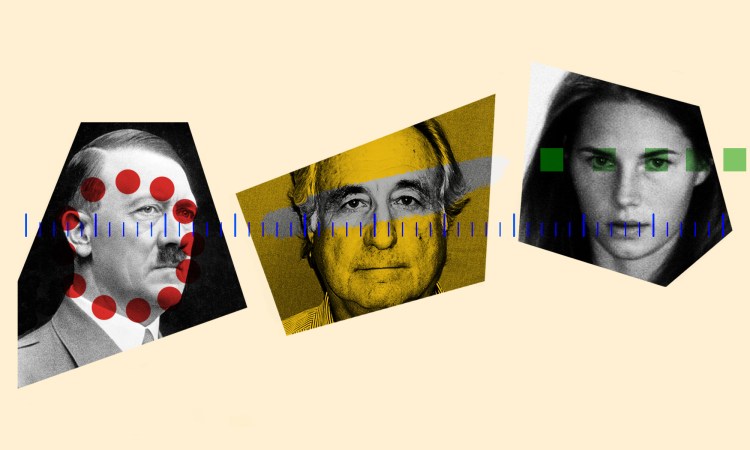
Most of us want to believe we would have flagged Hitler and Madoff right away had we met them in person. But would we have? In a thought-provoking new book, writer Malcolm Gladwell argues that our inborn tendencies and biases skew our judgement and prevent us from spotting the evil among us.
In his newest book Talking to Strangers, New Yorker writer Malcolm Gladwell once again shines a light on human behavior and relationships. But this time, he focuses on some of recent history’s most infamous villains, such as Adolf Hitler, Bernie Madoff and Jerry Sandusky.
Besides their crimes, these people had something else noteworthy in common — for a while, they all largely flew under the radar. With Hitler, world leaders didn’t fully perceive how big or unstable a threat he was; with Madoff and Sandusky, their colleagues and associates thought they were law-abiding folk.
What happened? Were those in their midst oblivious or naive?
Gladwell says the tendencies that led people to misread them exist in every one of us. “We think we can easily see into the hearts of others based on the flimsiest of clues … We would never do that to ourselves, of course,” he writes. “We are nuanced and complex and enigmatic. But the stranger is easy. If I can convince you of one thing in this book, let it be this: Strangers are not easy.”
While there are enough a-ha moments and epiphanies*** to be extracted from Talking to fill, well, a book, some of Gladwell’s most actionable insights have to do with the misconceptions we carry into our meetings with new people and the mistakes we make when appraising them.
Mistake #1: We rely too heavily on our face-to-face impressions when assessing other people.
British Prime Minister Neville Chamberlain was one of the few world leaders to sit down with Adolf Hitler (they had three meetings). After spending hours together, Chamberlain felt they had a rapport and told advisors that Hitler showed “no signs of insanity but many of excitement.” He trusted Hitler when he promised that his territorial interests didn’t extend past the Sudetenland. Boy was he wrong.
Yet it wasn’t just Chamberlain. Many other people — from heads of state right down to the citizens of England — had a similar faith in the diagnostic power of the firsthand observation, so they prized and repeated Chamberlain’s opinions. We’re all prone to this, says Gladwell. “We believe that the information gathered from a personal interaction is uniquely valuable,” he writes. “You would never hire a babysitter for your children without meeting that person first. Companies don’t hire employees blind. They call them in and interview them closely, sometimes for hours at a time, on more than one occasion.”
In fact, the politicians who most clearly saw the danger posed by Hitler were the ones who never met him. In other compellingly argued examples, which include a senior US intelligence operative who was secretly a spy for Cuba and the process used by NYC judges to decide whether to release defendants on bail, Gladwell demonstrates that our susceptibility to being misled by our own impressions is ongoing and widespread.
Mistake #2: We assume that people are honest, so it takes a great deal of evidence for us to believe that they aren’t.
For over a decade, Penn State assistant football coach Jerry Sandusky and USA Gymnastics team doctor Larry Nassar got away with sexually abusing countless young people. While allegations about them did surface over time, these were dismissed because of the men’s professional standing and their reputable defenders. Only after an undeniable amount of survivors came forward with their stories were the men thoroughly investigated and convicted for their crimes.
Gladwell explains how Sandusky and Nassar evaded detection with the Truth Default Theory of psychologist Tim Levine, who has spent years studying why we’re terrible at discerning lies and liars. Anyone who’s ever wondered “Are people inherently good or inherently evil?” will be fascinated by his research; Levine contends that humans in general believe we’re on Team Good. When attempting to gauge the character of those we meet, “[w]e do not behave … like sober-minded scientists slowly gathering evidence of the truth or falsity of something before reading a conclusion,” writes Gladwell. “We start by believing. And we stop believing only when our doubts and misgivings rise to the point where we can no longer explain them away.”
In a heartbreaking section, Gladwell discusses the gymnasts’ parents who initially sided with Nassar. Some of them, interviewed for the Believed podcast, described how they rationalized away the concerns they had. As Gladwell writes, “Default to truth becomes an issue when we are forced to choose between two alternatives, one of which is likely and the other of which is impossible to imagine.” In this light, it was much easier for parents to believe in the facade that Nassar presented — he was a doctor who held an eminent position and had credible allies to vouch for him — than to accept a truth that was gut-wrenching to contemplate — he was committing “unspeakably monstrous” offenses on their own children and they’d permitted their kids to be with him.
Mistake #3: We think that the people we meet are as easy to read as the actors on Friends.
In the third part of Strangers, Gladwell examines the appeal of this long-running sitcom — and he argues that a large part of its popularity is because it’s as subtle as a sledgehammer. Through their facial expressions and body language, the actors mime their intentions and reactions with such a satisfying clarity that you can follow the plot with the sound turned off.
Gladwell uses the obviousness of Friends to illustrate transparency, another of Levine’s findings. Transparency is the erroneous belief, writes Gladwell, that “the way [people] represent themselves on the outside … provides an authentic and reliable window into the way they feel on the inside.” In experiments, Levine found that participants were adept at spotting liars who acted like we think liars should (they exhibited tells such as fake smiles, too much or too little eye contact, or a change in their vocal tone). However, they faltered when it came to spotting liars who didn’t display such tics. As Gladwell points out, due to our transparency bias, we’re frequently confounded in our daily lives because — unlike the cast of Friends — most people aren’t overt in telegraphing their inner states.
Mistake #4: We’re particularly thrown by people whose external appearance doesn’t match who they actually are.
Gladwell calls this the mismatch problem. Take Bernie Madoff. With his sweep of white hair, bespoke suits and secretive demeanor, he fit the image of an investment genius. That — combined with our tendency to default to truth — allowed him to run the biggest Ponzi scheme in history. While many people had questions about his unusual success, they didn’t dig deeper (tormented Harry Markopolos, one of Talking’s most unforgettable characters, was a rare exception). Madoff’s scheme came apart when he ran out of money to pay investors and confessed to his sons. Until then, even though he was guilty, he appeared innocent (or innocent enough) to the eyes of the world and escaped scrutiny.
Mismatch can work the other way, and Gladwell unpacks the story of college student Amanda Knox to show how. An American studying in Italy, Knox was roommates with Meredith Kercher. When Kercher was found dead in their apartment, Knox and two suspected accomplices were arrested. In interviews with the police and in court appearances, “Foxy Knoxy” didn’t conform to notions of how a blameless person should behave. She spoke loudly, laughed with her boyfriend, and swiveled her hips in front of detectives at the crime scene. The investigation was also badly bungled, and she was convicted of murder and sent to prison. Then, after legal appeals and credible evidence implicated the actual perpetrator, Knox was completely exonerated. Her real crime was “her weirdness,” according to Gladwell. “We have built a world that systematically discriminates against a class of people who, through no fault of their own, violate our ridiculous ideas about transparency,” he writes.
So how can we counter these enormous blind spots?
Gladwell offers several intriguing suggestions, and these are the three most relevant here.
We must acknowledge that we’re poor judges of character and that our vision is distorted by some very human biases and fallacies.
We need to consider all of the information available about the people we meet, instead of depending on our visual impressions of them.
We should strive to bring openness and compassion to our interactions and extend forgiveness to anyone that wrongly defends a person who turns out to be a criminal.
***In Talking, Gladwell also delves into the tragic stories of Sandra Bland (a motorist in Texas who was stopped for failing to signal; she was arrested and hanged herself in a jail cell) and Brock Turner (the Stanford University freshman who met a young woman at a frat party and raped her afterward) to highlight some of the worst consequences that can emerge from our encounters with strangers.
Watch Malcolm Gladwell’s TED Talk about choice, happiness and, yes, spaghetti sauce:
Watch Malcolm Gladwell’s TED Talk about David and Goliath:











